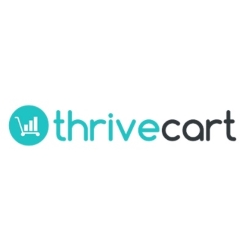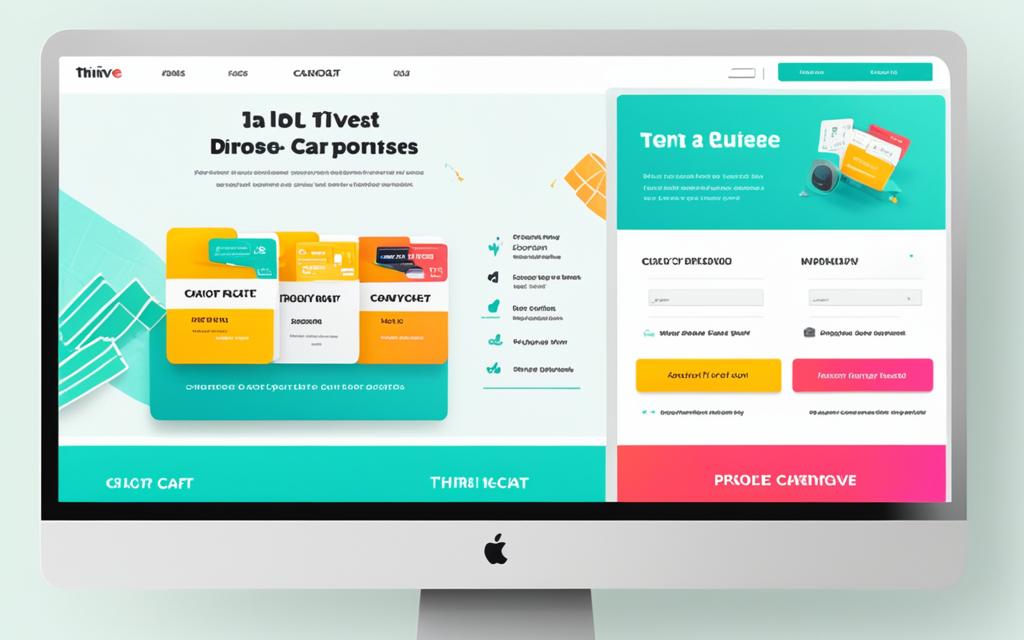As an online business owner, you know how important it is to have a reliable payment processing platform that seamlessly collects payments from your customers.
The right platform can make all the difference in optimizing conversions and boosting sales. That’s why we’re here to guide you through a comparison between two popular solutions: ThriveCart and Stripe.
ThriveCart is trusted by over 100,000 online businesses, providing a comprehensive set of features to streamline your payment collection process.
On the other hand, Stripe is a well-known global payment processor that offers flexibility and reliability for businesses of all sizes.
Stripe, unfortunately, lacks the customization options provided by ThriveCart, potentially impacting your long-term costs due to the limitations of standard checkout and sales pages.
Create high-converting cart pages, funnels, affiliate campaigns, courses and more.
However, by combining ThriveCart with Stripe, you can have the best of both worlds. ThriveCart integrates seamlessly with Stripe, providing you with a powerful payment processing solution that also offers enhanced customization.
In the upcoming sections, we’ll delve deeper into ThriveCart and Stripe, covering topics such as ease of use, payment processing, customization, integrations, and pricing.
By the end, you’ll have all the information you need to pick the right tool for your needs.
Also Read: How To Create Landing Pages Using ThriveCart?
Introduction to ThriveCart and Stripe
ThriveCart
ThriveCart is a shopping cart software designed to simplify the process of selling digital products, such as eBooks, courses, and membership sites, online.
It provides a comprehensive platform for entrepreneurs to manage their digital businesses, including checkout pages, payment gateways, and sales funnels.
ThriveCart offers various features to boost sales, such as order bumps, upsells, and down sells, making it an effective tool for maximizing revenue on each sale.
Also Read: Best ThriveCart Alternatives
Stripe
Stripe is a financial infrastructure platform that provides payment-processing software and application programming interfaces (APIs) for ecommerce websites and mobile applications.
It allows businesses to integrate payment processing into their platforms, enabling secure and efficient transactions.
Stripe offers a range of features, including fraud protection tools, billing products for subscription recurring revenue, and point-of-sale services.
The company is known for its scalability, flexibility, and ease of use, making it a popular choice for businesses of all sizes.
Explore: SamCart vs Stripe
Ease of Use & Interface
When it comes to the ease of use and interface, both ThriveCart and Stripe offer unique experiences to cater to different user needs.
ThriveCart is known for its user-friendly interface and intuitive design. It provides a seamless onboarding process, making it easy for beginners to set up their online store and start selling quickly.
The platform’s drag-and-drop functionality allows you to effortlessly customize your storefront without any coding knowledge.
Additionally, ThriveCart provides step-by-step tutorials and helpful guides to assist you throughout the setup process.
On the other hand, Stripe offers a robust and developer-friendly platform.
Create high-converting cart pages, funnels, affiliate campaigns, courses and more.
It provides extensive documentation and resources for developers who want to customize and integrate payment processing functionalities into their own applications.
For users with technical expertise, Stripe offers flexibility and the ability to create highly customized payment experiences tailored to specific business requirements.
If you’re looking for a user-friendly interface and ease of use, ThriveCart is an excellent choice.
However, if you require more customization and have the technical expertise to implement it, Stripe offers a powerful platform to meet your needs.
Check Out: ThriveCart vs ConvertKit
Payment Processing
When it comes to payment processing, both ThriveCart and Stripe offer secure and reliable solutions that ensure your transactions are handled with utmost safety and efficiency.
ThriveCart understands the importance of providing multiple payment options to cater to the diverse needs of your customers.
That’s why it seamlessly integrates with various tools such as Stripe and PayPal to offer a wide range of payment gateways.
Stripe, on the other hand, is renowned for its flexibility and continuous improvement in the field of payment processing.
As a dedicated payment processor, it offers seamless integration and takes care of all the intricacies involved in processing online transactions, providing you with a smooth and streamlined experience.
With ThriveCart’s robust integration capabilities and Stripe’s expertise in payment processing, you have the freedom and peace of mind to offer your customers a variety of payment options.
From credit card transactions to digital wallets, you can ensure a convenient checkout process for your customers, boosting customer satisfaction and increasing conversions.
Also Read: ThriveCart vs SendOwl
Customization & Flexibility
One of the key advantages of using ThriveCart for your online business is the extensive customization options it offers.
With ThriveCart, you have the freedom to create a unique storefront that aligns with your brand image and resonates with your customers.
The platform provides a library of customizable drag-and-drop page and cart templates, allowing you to easily customize the look and feel of your order forms and sales pages.
In addition to visual customization, ThriveCart also allows for customizing the checkout process. You can create personalized upsells, downsells, and bump sales without the need for external plugins.
Create high-converting cart pages, funnels, affiliate campaigns, courses and more.
The level of customization empowers businesses to maximize leads and increase their sales revenue.
Stripe, though, offers flexibility through its API (Application Programming Interface). Developers can leverage this API to customize the payment platform and tailor it to their specific business requirements.
The flexibility allows businesses to build a payment processing solution that seamlessly integrates with their existing systems and workflows.
It’s important to note that while ThriveCart offers extensive customization options, Stripe does not allow customization of order forms.
However, Stripe’s longevity in the market and its reputation as a trusted payment processor make it a reliable choice for businesses.
Also Read: ThriveCart vs 1ShoppingCart
Integrations
One of the key advantages of choosing the right payment processing platform for your online business is the ability to seamlessly integrate with other tools and services.
Both ThriveCart and Stripe offer a wide range of third-party integrations that can enhance the functionality and efficiency of your online store.
ThriveCart integrates with popular email marketing platforms, membership sites, and other tools, allowing you to automate your marketing efforts and streamline your operations.
With ThriveCart’s integrations, you can easily connect with platforms like MailChimp, ActiveCampaign, and ConvertKit to support your email marketing strategies and build stronger relationships with your customers.
Stripe, being widely used for payment processing by mainstream websites, also provides a wealth of integrations.
It seamlessly connects with various business tools and platforms, allowing you to extend its capabilities beyond payment processing.
From Zapier for workflow automation to Salesforce for customer relationship management, Stripe offers a comprehensive set of integrations to meet your specific business needs.
By integrating ThriveCart with Stripe, you can leverage the strengths of both platforms for optimized functionality in collecting payments and creating custom order forms and sales pages.
ThriveCart’s customization options combined with Stripe’s reliable payment processing capabilities create a powerful toolset that allows you to create a seamless and professional shopping experience for your customers.
Whether you choose ThriveCart or Stripe, the extensive integrations available ensure that you can connect your payment processing system with the tools and services you already rely on.
This not only saves you time and effort but also enables you to automate processes and streamline your business operations.
Check Out: ThriveCart vs Kajabi
Pricing
ThriveCart
ThriveCart offers two main pricing options:
- ThriveCart Standard: This is a one-time payment of $495 for a lifetime license. This includes the core ThriveCart shopping cart features such as checkout pages, payment integrations, sales funnels, and more.
- ThriveCart Pro: This is an additional one-time payment of $195 on top of the standard license. The Pro version adds more advanced features like an affiliate center, subscription saver, JV contracts, and custom domain support.
Create high-converting cart pages, funnels, affiliate campaigns, courses and more.
In addition to the two main plans, ThriveCart also offers:
- ThriveCart Learn: This is a course and membership platform that comes included for free with the purchase of ThriveCart or ThriveCart Pro.
- ThriveCart Learn+: This is an optional add-on for $195 that provides additional features for the course and membership platform.
ThriveCart’s pricing is very competitive compared to other shopping cart solutions like SamCart, which has a monthly subscription fee. ThriveCart’s one-time payment model is seen as a major advantage.
Also Read: SamCart vs ConvertKit
Stripe
Stripe offers transparent pricing with no setup fees or monthly fees. The company charges per transaction, which includes various fees depending on the type of transaction and the payment method used.
Here are the key details on Stripe pricing:
Online Transactions
- Standard Fee: 2.9% + 30 cents per successful card charge.
- International Transactions: Additional 1% fee for international cards and 1% for currency conversion if required.
In-Person Transactions
- Standard Fee: 2.7% + 5 cents per successful card charge.
- International Transactions: Additional 1% fee for international cards and 1% for currency conversion if required.
Additional Fees
- ACH Credit: $1 per ACH credit payment.
- Wire: $8 per wire payment.
- Checks: $5 per check received.
- ACH Direct Deposit: 0.8% per transaction with a maximum ACH fee of $5.
Custom Pricing
- Large-Volume Discounts: Available for businesses with high payment volumes.
- Multiproduct Discounts: Discounts for businesses with multiple products.
- Country-Specific Rates: Custom rates for specific countries.
- Interchange Pricing: Custom pricing based on the specific interchange fees.
Instant Payouts
- Additional 1% Fee: Charged for instant payouts, with a minimum fee of 50 cents per transaction.
International Support
- Supported Countries: 47 countries, including Canada, Brazil, Japan, and Croatia.
- Currency Support: Accepts more than 135 currencies, allowing businesses to present prices in the customer’s native currency.
Credit Card Terminals
- Pricing: Varies by terminal type, starting at $59 for mobile card readers and going up to $249 for countertop terminals.
Check Out: ThriveCart vs Hotmart
Conclusion
ThriveCart stands out with its integrated upselling features that can potentially increase your average order value and revenue without being intrusive.
It also prioritizes user-friendly features like lightning-fast one-click purchases, order bumps, abandoned cart recovery emails, and optimized sales funnels to improve your conversion rates.
Unlike ThriveCart, Stripe is more of a payment processing platform that integrates seamlessly with ThriveCart and other tools.
It provides flexibility for transaction processing, with a wide range of payment processor integrations, including popular options like Stripe, PayPal, and Authorize.net.
ThriveCart is recommended for online retailers seeking streamlined sales processes and digital product sellers. However, if you require advanced inventory management or extensive shipping needs, it may not be the best fit for your business.














